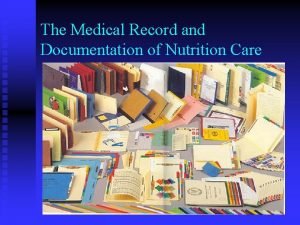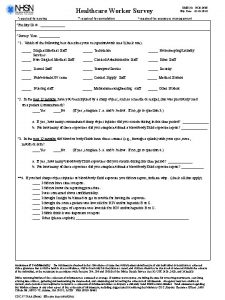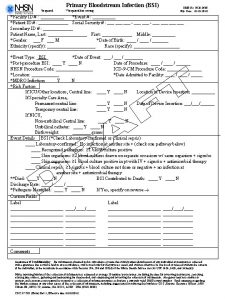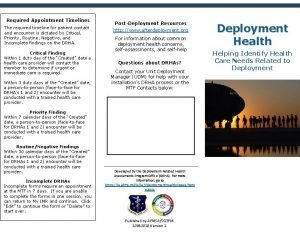Note Nutrition 101 tutor TUTOR REQUIRED FOR NUTRITION




















- Slides: 20

Note Nutrition 101 tutor TUTOR REQUIRED FOR NUTRITION 101 CONTACT DR. BARRE IF YOU OR SOMEONE ELSE ARE INTERESTED. A student tutoring for the Jennifer Keeping Centre is paid $15 per hour. Students typically get tutored 2 hours a week. They can be tutored right up until the end of the term or sooner depending on the student's needs.

Lecture 4 a 31 January 2011 Diabetes Type II Pathology-4 a Nutritional Intervention-4 b Functional Food/Nutraceutical Approaches-4 c

Pathology Role of insulin -produced in the beta cells of the pancreas -initially synthesised as a single chain 86 amino acid polypeptide (pre-proinsulin) -post-translational modification removes the amino terminal signal peptide what is a signal peptide?

Role of insulin -this give rise to proinsulin -insulin is created via the cleavage of an internal peptide (31 mer) and the A (21 mer) and B(30 mer) chains of insulin are then linked together by a disulphide linkage (enzyme responsible? )



Causes of Type I-genetic -concordance is 30 -70 % in identical twins -polymorphisms in HLA complex appear to account for 40 -50 % of type I -HLA complex contains genes for the class II MHC molecules which present antigen to helper T cells and are thus involved in initiating the immune response -ability of class II MHC molecules to present antigen is dependent on the amino acid composition of their antigen binding sites


Genetic -amino acid substitutions may influence the specificity of the immune response by altering the binding affinity of different antigens for the class II molecules -10 % of genetic risk due to polymorphisms in the promoter region of the insulin gene

Causes of Type I -autoimmune- beta cells produced proteins that mediate draw lymphocytes into pancreas where they infiltrate islets (insulitis) and selectively attack beta cells- inflammation leads to atrophy of b-cells -immunological markers-islet cell autoantibodiesthese antibodies are directed at a series of b-cell proteins -environmental-viruses-coxsackie and rubella -bovine milk -nitrosamines

Type II-no longer adult NIDDM - affects children and insulin can be used

-genetic factors -concordance of 70 -90 % in identical twinsquestion this -40 % if both parents have it-question this as well -polymorphisms or mutations in insulin receptor and enzymes involved in glucose homeostasis (candidates? )

-pathophysiology -increased hepatic glucose synthesis because as insulin sensitivity drops the ability of insulin to promote glycogen synthesis and suppress gluconeogenesis drops -impaired insulin sensitivity

Pathophysiology continued -impaired insulin production-reason is unknown-though glucose toxicity while undefined cripples beta cell-suggestions -increased free fatty acids impair b-cell function

Metabolic syndrome -obesity -kick-off via increased free fatty acids -measures -BMI -percentage fat-skinfolds underwater weighing -height-weight tables -free fatty acids regulate insulin sensitivity

Metabolic syndrome -free fatty acids regulate insulin sensitivity -free fatty acids decrease glucose utilisation and increase hepatic glucose production

-lipids-including decreased anti-oxidation capacity -increased free fatty acids -decreased HDLc, increased CETP, decreased LPL -increased cholesterol, LDLc -increased triglycerides

Metabolic syndrome -blood pressure -elevated -platelet aggregation- Tripepidemiology slide

PLATELET HYPERREACTIVITY AND MYOCARDIAL INFARCTION* SPA STATUS AND NUMBER OF PATIENTS TOTAL MORTALITY 149 CARDIAC EVENTS 18 33 SPA NEG. 94 6 (6. 4 %) 14 (14. 9 %) SPA INT. 29 3 (10. 3 %) 7 SPA POS. 26 9 (34. 6 %) 12 (46. 2 %) (24. 1 %) 12 MOS. DATA OF Trip et al. NEJM 322: 1549 (1990) SPA = SPONTANEOUS PLATELET AGGREGATION

Metabolic syndrome -insulin sensitivity-receptor binding efficiency -right shift in insulin dose response curve and downward shift in maximal impact -as insulin sensitivity goes down the lipids are further perturbed -ultimately may get pancreatic failure with requirement for insulin injections
 Simple interest note vs simple discount note
Simple interest note vs simple discount note Difference between note making and note taking
Difference between note making and note taking Debit note example
Debit note example Signal words examples
Signal words examples Debit note tax invoice
Debit note tax invoice Difference between note making and note taking
Difference between note making and note taking Relevance of note making
Relevance of note making Financial documents order
Financial documents order Cornell note taking method
Cornell note taking method According to walter pauk, 10 weeks after lecture
According to walter pauk, 10 weeks after lecture Adime chart note example
Adime chart note example Shingelfrisyren
Shingelfrisyren Vad är verksamhetsanalys
Vad är verksamhetsanalys Tack för att ni har lyssnat
Tack för att ni har lyssnat Stål för stötfångarsystem
Stål för stötfångarsystem Vad står k.r.å.k.a.n för
Vad står k.r.å.k.a.n för Centrum för kunskap och säkerhet
Centrum för kunskap och säkerhet Läkarutlåtande för livränta
Läkarutlåtande för livränta Shaktismen
Shaktismen Inköpsprocessen steg för steg
Inköpsprocessen steg för steg Påbyggnader för flakfordon
Påbyggnader för flakfordon







































